

Compact Muon Solenoid
LHC, CERN
| CMS-EXO-16-057 ; CERN-EP-2018-007 | ||
| Search for narrow resonances in the b-tagged dijet mass spectrum in proton-proton collisions at $\sqrt{s} = $ 8 TeV | ||
| CMS Collaboration | ||
| 17 February 2018 | ||
| Phys. Rev. Lett. 120 (2018) 201801 | ||
| Abstract: A search for narrow resonances decaying to bottom quark-antiquark pairs is presented, using a data sample of proton-proton collisions at $\sqrt{s} = $ 8 TeV corresponding to an integrated luminosity of 19.7 fb$^{-1}$. The search is extended to masses lower than those reached in typical searches for resonances decaying into jet pairs at the LHC, by taking advantage of triggers that identify jets originating from bottom quarks. No significant excess of events is observed above the background predictions. Limits are set on the product of cross section and branching fraction to bottom quarks for spin 0, 1, and 2 resonances in the mass range of 325-1200 GeV. These results significantly improve on the limits for resonances decaying into jet pairs in the 325-500 GeV mass range. | ||
| Links: e-print arXiv:1802.06149 [hep-ex] (PDF) ; CDS record ; inSPIRE record ; CADI line (restricted) ; | ||
| Figures | |
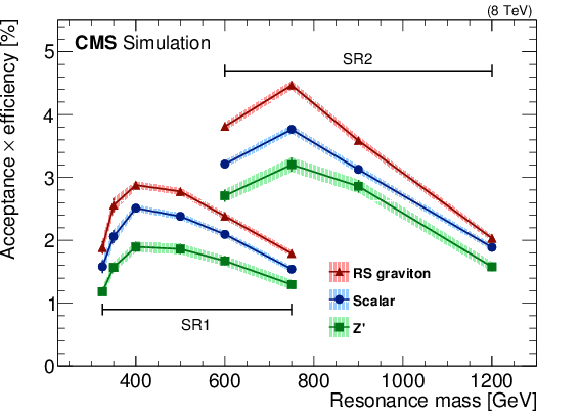
png pdf |
Figure 1:
The products of acceptance and efficiency for simulated signal events in SR1 and SR2, separately for the scalar, Z', and RS graviton signal models. The shaded bands represent the statistical uncertainties. |
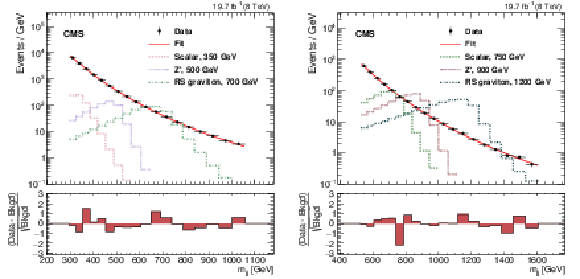
png pdf |
Figure 2:
The dijet invariant mass distributions in SR1 (left) and SR2 (right), shown with the background prediction derived from a fit using an empirical function under the background-only hypothesis. Representative examples of signal distributions are also shown, each normalized to a visible cross section of 1 pb. The bottom panels show the difference between the data and the background estimate, divided by the statistical uncertainty in the estimated background. |
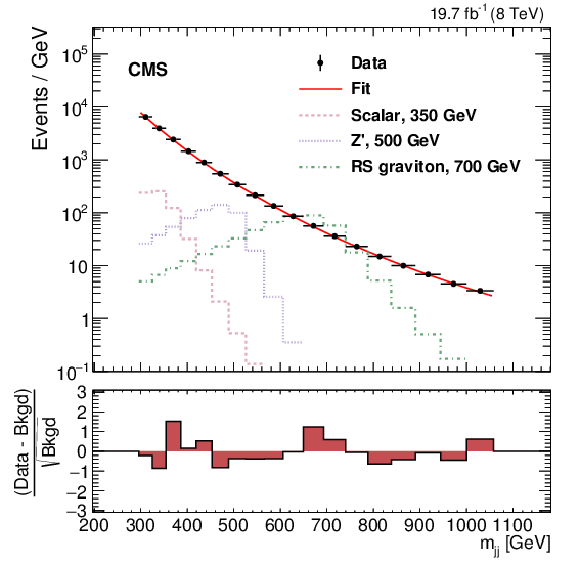
png pdf |
Figure 2-a:
The dijet invariant mass distribution in SR1, shown with the background prediction derived from a fit using an empirical function under the background-only hypothesis. Representative examples of signal distributions are also shown, each normalized to a visible cross section of 1 pb. The bottom panel shows the difference between the data and the background estimate, divided by the statistical uncertainty in the estimated background. |
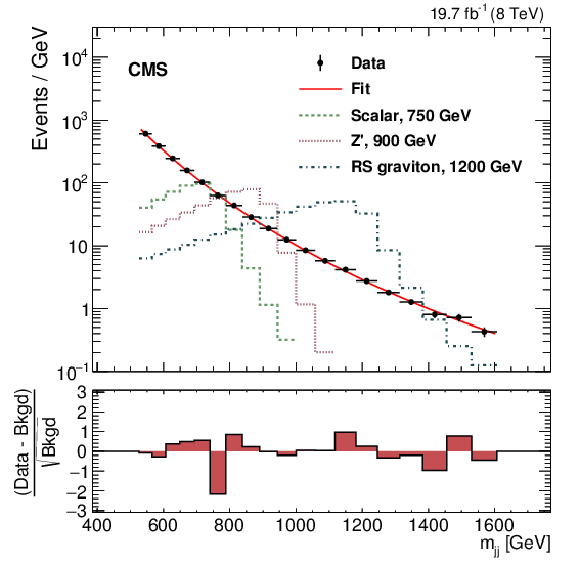
png pdf |
Figure 2-b:
The dijet invariant mass distribution in SR2, shown with the background prediction derived from a fit using an empirical function under the background-only hypothesis. Representative examples of signal distributions are also shown, each normalized to a visible cross section of 1 pb. The bottom panel shows the difference between the data and the background estimate, divided by the statistical uncertainty in the estimated background. |

png pdf |
Figure 3:
Observed and expected 95% CL upper limits on the product of cross section and branching fraction to bottom quark-antiquark pairs for a scalar resonance (left), Z' boson (middle), and RS graviton (right) signal models, as functions of resonance mass. The discontinuity in the limits at 700 GeV is associated with a change in the acceptance from SR1 to SR2. |
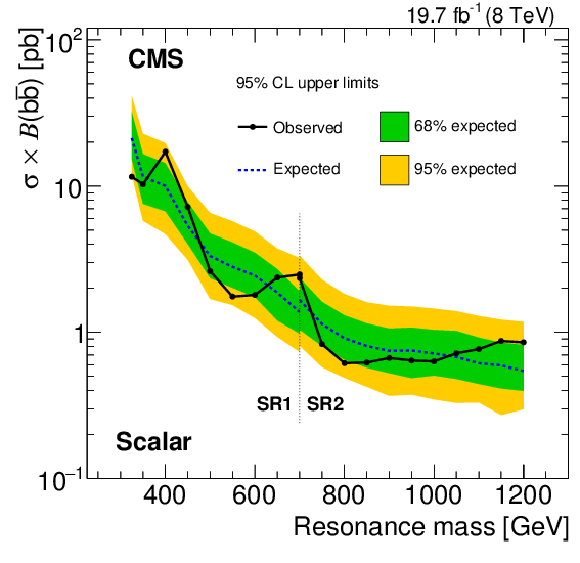
png pdf |
Figure 3-a:
Observed and expected 95% CL upper limits on the product of cross section and branching fraction to bottom quark-antiquark pairs for a scalar resonance signal model, as functions of resonance mass. The discontinuity in the limits at 700 GeV is associated with a change in the acceptance from SR1 to SR2. |

png pdf |
Figure 3-b:
Observed and expected 95% CL upper limits on the product of cross section and branching fraction to bottom quark-antiquark pairs for a Z' boson signal model, as functions of resonance mass. The discontinuity in the limits at 700 GeV is associated with a change in the acceptance from SR1 to SR2. |

png pdf |
Figure 3-c:
Observed and expected 95% CL upper limits on the product of cross section and branching fraction to bottom quark-antiquark pairs for a RS graviton signal model, as functions of resonance mass. The discontinuity in the limits at 700 GeV is associated with a change in the acceptance from SR1 to SR2. |

png pdf |
Figure 4:
Left: The 95% CL upper limits (solid line) on the universal coupling ${g'_ {\mathrm {q}}} $ between the leptophobic Z' boson and quarks. Limits from other experiments [2,8,9,18] and earlier CMS analyses [33,34,37], are also shown, along with an indirect constraint from the Z boson width [74]. Right: Expected (dashed lines) and observed (solid lines) 95% CL upper limits on the simplified model variable $\zeta $. The limits are shown for $ {\mathrm {u}} {\overline {\mathrm {u}}} \to {\mathrm {Z}'}$ and $ {\mathrm {d}} {\overline {\mathrm {d}}} \to {\mathrm {Z}'}$ individually, as well as for $ {\mathrm {p}} {\mathrm {p}}\to {\mathrm {Z}'}$, assuming a universal quark coupling. The $\zeta $ values for the Z' boson model with $ {g'_ {\mathrm {q}}} = $ 0.25 are also shown. The hatched red band represents the envelope of limits for theoretical models that predict an $s$-channel production of a Z' resonance with arbitrary couplings to up and down quarks. The discontinuity in the limits at 700 GeV is associated with a change in the acceptance from SR1 to SR2. |

png pdf |
Figure 4-a:
The 95% CL upper limits (solid line) on the universal coupling ${g'_ {\mathrm {q}}} $ between the leptophobic Z' boson and quarks. Limits from other experiments [2,8,9,18] and earlier CMS analyses [33,34,37], are also shown, along with an indirect constraint from the Z boson width [74]. The discontinuity in the limits at 700 GeV is associated with a change in the acceptance from SR1 to SR2. |
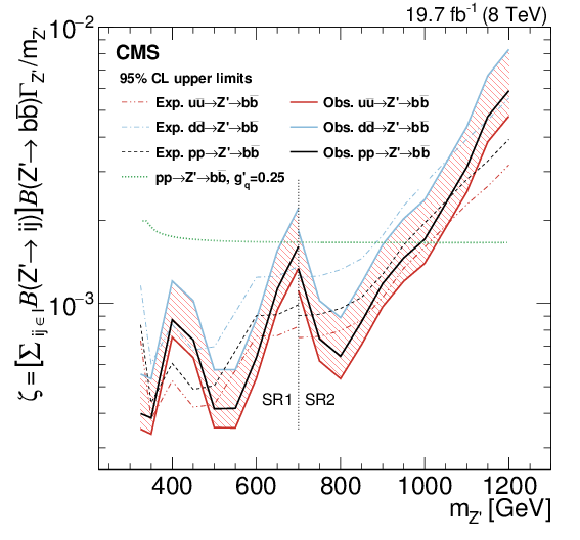
png pdf |
Figure 4-b:
Expected (dashed lines) and observed (solid lines) 95% CL upper limits on the simplified model variable $\zeta $. The limits are shown for $ {\mathrm {u}} {\overline {\mathrm {u}}} \to {\mathrm {Z}'}$ and $ {\mathrm {d}} {\overline {\mathrm {d}}} \to {\mathrm {Z}'}$ individually, as well as for $ {\mathrm {p}} {\mathrm {p}}\to {\mathrm {Z}'}$, assuming a universal quark coupling. The $\zeta $ values for the Z' boson model with $ {g'_ {\mathrm {q}}} = $ 0.25 are also shown. The hatched red band represents the envelope of limits for theoretical models that predict an $s$-channel production of a Z' resonance with arbitrary couplings to up and down quarks. The discontinuity in the limits at 700 GeV is associated with a change in the acceptance from SR1 to SR2. |
| Summary |
| In summary, a search for new resonances decaying to bottom quark-antiquark pairs produced in 8 TeV proton-proton collisions has been presented. Using triggers that identify jets originating from bottom quarks, the search probes signal masses as low as 325 GeV. No statistically significant excesses above the background predictions are observed in the entire invariant mass range studied, 325--1200 GeV. Upper limits are set on the production cross section of scalar, vector, and tensor resonances. The limits are also interpreted in the context of a simplified model of a leptophobic Z' boson with a universal coupling ${g'_ {\mathrm {q}}} $ to quarks. Values of ${g'_ {\mathrm {q}}} $ above 0.11--0.18 are excluded for Z' boson masses below 500 GeV, improving on the previous best limits in this mass range, which date back to the CDF experiment. The first experimental limits on the parameter $\zeta$ of a simplified $s$-channel resonance framework [80] have been obtained, making possible the reinterpretation of the limits in a variety of theoretical models corresponding to different resonance production and decay mechanisms. |
| References | ||||
| 1 | UA1 Collaboration | Two-jet mass distributions at the CERN proton-antiproton collider | PLB 209 (1988) 127 | |
| 2 | UA2 Collaboration | A measurement of two-jet decays of the $ W $ and $ Z $ bosons at the CERN $ {\bar{p} p} $ collider | Z. Phys. C 49 (1991) 17 | |
| 3 | UA2 Collaboration | A search for new intermediate vector mesons and excited quarks decaying to two jets at the CERN $ {\rm \bar{p} p} $ collider | NPB 400 (1993) 3 | |
| 4 | CDF Collaboration | The two-jet invariant mass-distribution at $ \sqrt{s} = $ 1.8 TeV | PRD 41 (1990) 1722(R) | |
| 5 | CDF Collaboration | Search for quark compositeness, axigluons and heavy particles using the dijet invariant mass spectrum observed in $ {\rm \bar{p} p} $ collisions | PRL 71 (1993) 2542 | |
| 6 | CDF Collaboration | Search for new particles decaying to dijets in $ {\rm \bar{p} p} $ collisions at $ \sqrt{s} = $ 1.8 TeV | PRL 74 (1995) 3538 | hep-ex/9501001 |
| 7 | CDF Collaboration | Measurement of dijet angular distributions by the Collider Detector at Fermilab | PRL 77 (1996) 5336 | hep-ex/9609011 |
| 8 | CDF Collaboration | Search for new particles decaying to dijets at CDF | PRD 55 (1997) 5263(R) | hep-ex/9702004 |
| 9 | CDF Collaboration | Search for new particles decaying into dijets in proton-antiproton collisions at $ \sqrt{s} = $ 1.96 TeV | PRD 79 (2009) 112002 | 0812.4036 |
| 10 | D0 Collaboration | Measurement of dijet angular distributions and search for quark compositeness | PRL 80 (1998) 666 | hep-ex/9707016 |
| 11 | D0 Collaboration | The dijet mass spectrum and a search for quark compositeness in $ {\rm \bar{p} p} $ collisions at $ \sqrt{s} = $ 1.8 TeV | PRL 82 (1999) 2457 | hep-ex/9807014 |
| 12 | D0 Collaboration | Search for new particles in the two-jet decay channel with the D0 detector | PRD 69 (2004) 111101(R) | hep-ex/0308033 |
| 13 | ATLAS Collaboration | Search for new particles in two-jet final states in 7 TeV proton-proton collisions with the ATLAS detector at the LHC | PRL 105 (2010) 161801 | 1008.2461 |
| 14 | ATLAS Collaboration | Search for quark contact interactions in dijet angular distributions in pp collisions at $ \sqrt{s}= $ 7 TeV measured with the ATLAS detector | PLB 694 (2011) 327 | 1009.5069 |
| 15 | ATLAS Collaboration | A search for new physics in dijet mass and angular distributions in pp collisions at $ \sqrt{s} = $ 7 TeV measured with the ATLAS detector | New J. Phys. 13 (2011) 053044 | 1103.3864 |
| 16 | ATLAS Collaboration | Search for new physics in the dijet mass distribution using 1 fb$ ^{-1} $ of pp collision data at $ \sqrt{s}= $ 7 TeV collected by the ATLAS detector | PLB 708 (2012) 37 | 1108.6311 |
| 17 | ATLAS Collaboration | ATLAS search for new phenomena in dijet mass and angular distributions using pp collisions at $ \sqrt{s}= $ 7 TeV | JHEP 01 (2013) 029 | 1210.1718 |
| 18 | ATLAS Collaboration | Search for new phenomena in the dijet mass distribution using pp collision data at $ \sqrt{s}= $ 8 TeV with the ATLAS detector | PRD 91 (2015) 052007 | 1407.1376 |
| 19 | ATLAS Collaboration | Search for new phenomena in dijet angular distributions in proton-proton collisions at $ \sqrt{s} = $ 8 TeV measured with the ATLAS detector | PRL 114 (2015) 221802 | 1504.00357 |
| 20 | ATLAS Collaboration | Search for new phenomena in dijet mass and angular distributions from $ pp $ collisions at $ \sqrt{s} = $ 13 TeV with the ATLAS detector | PLB 754 (2016) 302 | 1512.01530 |
| 21 | ATLAS Collaboration | Search for resonances in the mass distribution of jet pairs with one or two jets identified as $ b $-jets in proton--proton collisions at $ \sqrt{s}= $ 13 TeV with the ATLAS detector | PLB 759 (2016) 229 | 1603.08791 |
| 22 | ATLAS Collaboration | Search for new phenomena in dijet events using 37 fb$ ^{-1} $ of $ pp $ collision data collected at $ \sqrt{s}= $ 13 TeV with the ATLAS detector | PRD 96 (2017) 052004 | 1703.09127 |
| 23 | CMS Collaboration | Search for dijet resonances in 7 TeV pp collisions at CMS | PRL 105 (2010) 211801 | CMS-EXO-10-010 1010.0203 |
| 24 | CMS Collaboration | Search for quark compositeness with the dijet centrality ratio in pp collisions at $ \sqrt{s}= $ 7 TeV | PRL 105 (2010) 262001 | CMS-EXO-10-002 1010.4439 |
| 25 | CMS Collaboration | Measurement of dijet angular distributions and search for quark compositeness in pp collisions at $ \sqrt{s} = $ 7 TeV | PRL 106 (2011) 201804 | CMS-EXO-10-009 1102.2020 |
| 26 | CMS Collaboration | Search for resonances in the dijet mass spectrum from 7 TeV pp collisions at CMS | PLB 704 (2011) 123 | CMS-EXO-11-015 1107.4771 |
| 27 | CMS Collaboration | Search for quark compositeness in dijet angular distributions from pp collisions at $ \sqrt{s}= $ 7 TeV | JHEP 05 (2012) 055 | CMS-EXO-11-017 1202.5535 |
| 28 | CMS Collaboration | Search for narrow resonances and quantum black holes in inclusive and b-tagged dijet mass spectra from pp collisions at $ \sqrt{s}= $ 7 TeV | JHEP 01 (2013) 013 | CMS-EXO-11-094 1210.2387 |
| 29 | CMS Collaboration | Search for narrow resonances using the dijet mass spectrum in pp collisions at $ \sqrt{s} = $ 8 TeV | PRD 87 (2013) 114015 | CMS-EXO-12-016 1302.4794 |
| 30 | CMS Collaboration | Search for quark contact interactions and extra spatial dimensions using dijet angular distributions in proton-proton collisions at $ \sqrt{s} = $ 8 TeV | PLB 746 (2015) 79 | CMS-EXO-12-050 1411.2646 |
| 31 | CMS Collaboration | Search for resonances and quantum black holes using dijet mass spectra in proton-proton collisions at $ \sqrt{s} = $ 8 TeV | PRD 91 (2015) 052009 | CMS-EXO-12-059 1501.04198 |
| 32 | CMS Collaboration | Search for narrow resonances decaying to dijets in proton-proton collisions at $ \sqrt{s} = $ 13 TeV | PRL 116 (2016) 071801 | CMS-EXO-15-001 1512.01224 |
| 33 | CMS Collaboration | Search for narrow resonances in dijet final states at $ \sqrt{s}= $ 8 TeV with the novel CMS technique of data scouting | PRL 117 (2016) 031802 | CMS-EXO-14-005 1604.08907 |
| 34 | CMS Collaboration | Search for dijet resonances in proton-proton collisions at $ \sqrt{s} = $ 13 TeV and constraints on dark matter and other models | PLB 769 (2017) 520 | CMS-EXO-16-032 1611.03568 |
| 35 | CMS Collaboration | Search for new physics with dijet angular distributions in proton-proton collisions at $ \sqrt{s}= $ 13 TeV | JHEP 07 (2017) 013 | CMS-EXO-15-009 1703.09986 |
| 36 | CMS Collaboration | Search for low mass vector resonances decaying to quark-antiquark pairs in proton-proton collisions at $ \sqrt{s}= $ 13 TeV | PRL 119 (2017) 111802 | CMS-EXO-16-030 1705.10532 |
| 37 | CMS Collaboration | Search for low mass vector resonances decaying into quark-antiquark pairs in proton-proton collisions at $ \sqrt{s}= $ 13 TeV | JHEP 01 (2018) 097 | CMS-EXO-17-001 1710.00159 |
| 38 | ATLAS Collaboration | Search for light resonances decaying to boosted quark pairs and produced in association with a photon or a jet in proton-proton collisions at $ \sqrt{s}= $ 13 TeV with the ATLAS detector | 1801.08769 | |
| 39 | C. T. Hill | Topcolor assisted technicolor | PLB 345 (1995) 483 | hep-ph/9411426 |
| 40 | L. Randall and R. Sundrum | A large mass hierarchy from a small extra dimension | PRL 83 (1999) 3370 | hep-ph/9905221 |
| 41 | L. Randall and R. Sundrum | An alternative to compactification | PRL 83 (1999) 4690 | hep-th/9906064 |
| 42 | H. Davoudiasl, J. L. Hewett, and T. G. Rizzo | Experimental probes of localized gravity: On and off the wall | PRD 63 (2001) 075004 | hep-ph/0006041 |
| 43 | J. F. Gunion, S. Dawson, H. E. Haber, and G. L. Kane | The Higgs hunter?s guide | Addison--Wesley | |
| 44 | M. R. Buckley, D. Feld, and D. Goncalves | Scalar simplified models for dark matter | PRD 91 (2015) 015017 | 1410.6497 |
| 45 | U. Haisch and E. Re | Simplified dark matter top-quark interactions at the LHC | JHEP 06 (2015) 078 | 1503.00691 |
| 46 | CMS Collaboration | The CMS trigger system | JINST 12 (2017) P01020 | CMS-TRG-12-001 1609.02366 |
| 47 | CMS Collaboration | The CMS experiment at the CERN LHC | JINST 3 (2008) S08004 | CMS-00-001 |
| 48 | CMS Collaboration | Particle-flow reconstruction and global event description with the CMS detector | JINST 12 (2017) P10003 | CMS-PRF-14-001 1706.04965 |
| 49 | M. Cacciari, G. P. Salam, and G. Soyez | The anti-$ k_t $ jet clustering algorithm | JHEP 04 (2008) 063 | 0802.1189 |
| 50 | M. Cacciari, G. P. Salam, and G. Soyez | FastJet user manual | EPJC 72 (2012) 1896 | 1111.6097 |
| 51 | M. Cacciari and G. P. Salam | Pileup subtraction using jet areas | PLB 659 (2008) 119 | 0707.1378 |
| 52 | CMS Collaboration | Determination of jet energy calibration and transverse momentum resolution in CMS | JINST 6 (2011) P11002 | CMS-JME-10-011 1107.4277 |
| 53 | CMS Collaboration | Jet energy scale and resolution in the CMS experiment in pp collisions at 8 TeV | JINST 12 (2017) P02014 | CMS-JME-13-004 1607.03663 |
| 54 | CMS Collaboration | Jet performance in pp collisions at $ \sqrt{s} = $ 7 TeV | CMS-PAS-JME-10-003 | |
| 55 | CMS Collaboration | Identification of b-quark jets with the CMS experiment | JINST 8 (2013) P04013 | CMS-BTV-12-001 1211.4462 |
| 56 | CMS Collaboration | Performance of b tagging at $ \sqrt{s}= $ 8 TeV in multijet, $ {\rm t\bar t} $ and boosted topology events | CMS-PAS-BTV-13-001 | |
| 57 | CMS Collaboration | Description and performance of track and primary-vertex reconstruction with the CMS tracker | JINST 9 (2014) P10009 | CMS-TRK-11-001 1405.6569 |
| 58 | T. Sjostrand, S. Mrenna, and P. Z. Skands | A brief introduction to PYTHIA 8.1 | CPC 178 (2008) 852 | 0710.3820 |
| 59 | P. Skands, S. Carrazza, and J. Rojo | Tuning PYTHIA 8.1: the Monash 2013 tune | EPJC 74 (2014) 3024 | 1404.5630 |
| 60 | CMS Collaboration | Event generator tunes obtained from underlying event and multiparton scattering measurements | EPJC 76 (2016) 155 | CMS-GEN-14-001 1512.00815 |
| 61 | J. Alwall et al. | The automated computation of tree-level and next-to-leading order differential cross sections, and their matching to parton shower simulations | JHEP 07 (2014) 079 | 1405.0301 |
| 62 | NNPDF Collaboration | Parton distributions for the LHC Run II | JHEP 04 (2015) 040 | 1410.8849 |
| 63 | R. D. Ball et al. | Parton distributions with LHC data | NPB 867 (2013) 244 | 1207.1303 |
| 64 | T. Sjostrand, S. Mrenna, and P. Skands | PYTHIA 6.4 physics and manual | JHEP 05 (2006) 026 | hep-ph/0603175 |
| 65 | J. Pumplin et al. | New generation of parton distributions with uncertainties from global QCD analysis | JHEP 07 (2002) 012 | hep-ph/0201195 |
| 66 | CMS Collaboration | Study of the underlying event at forward rapidity in pp collisions at $ \sqrt{s} = $ 0.9, 2.76, and 7 TeV | JHEP 04 (2013) 072 | CMS-FWD-11-003 1302.2394 |
| 67 | GEANT4 Collaboration | GEANT4---a simulation toolkit | NIMA 506 (2003) 250 | |
| 68 | R. J. Barlow | Extended maximum likelihood | NIMA 297 (1990) 496 | |
| 69 | R. A. Fisher | On the interpretation of $ \chi^2 $ from contingency tables, and the calculation of $ p $ | J. Roy. Stat. Soc. 85 (1922) 87 | |
| 70 | A. D. Bukin | Fitting function for asymmetric peaks | 0711.4449 | |
| 71 | S. Alekhin et al. | The PDF4LHC working group interim report | 1101.0536 | |
| 72 | M. Botje et al. | The PDF4LHC working group interim recommendations | 1101.0538 | |
| 73 | CMS Collaboration | CMS luminosity based on pixel cluster counting - summer 2013 update | CMS-PAS-LUM-13-001 | CMS-PAS-LUM-13-001 |
| 74 | B. A. Dobrescu and C. Frugiuele | Hidden GeV-scale interactions of quarks | PRL 113 (2014) 061801 | 1404.3947 |
| 75 | G. Cowan, K. Cranmer, E. Gross, and O. Vitells | Asymptotic formulae for likelihood-based tests of new physics | EPJC 71 (2011) 1554 | 1007.1727 |
| 76 | T. Junk | Confidence level computation for combining searches with small statistics | NIMA 434 (1999) 435 | hep-ex/9902006 |
| 77 | A. L. Read | Presentation of search results: The $ CL_s $ technique | JPG 28 (2002) 2693 | |
| 78 | ATLAS and CMS Collaborations | Procedure for the LHC Higgs boson search combination in summer 2011 | ATL-PHYS-PUB-2011-011, CMS NOTE-2011/005 | |
| 79 | B. A. Dobrescu and F. Yu | Coupling-mass mapping of dijet peak searches | PRD 88 (2013) 035021 | 1306.2629 |
| 80 | R. S. Chivukula, P. Ittisamai, K. Mohan, and E. H. Simmons | Simplified limits on resonances at the LHC | PRD 94 (2016) 094029 | 1607.05525 |
| 81 | R. S. Chivukula, P. Ittisamai, K. Mohan, and E. H. Simmons | Broadening the reach of simplified limits on resonances at the LHC | PRD 96 (2017) 055043 | 1707.01080 |

|
Compact Muon Solenoid LHC, CERN |

|

|

|

|

|

|